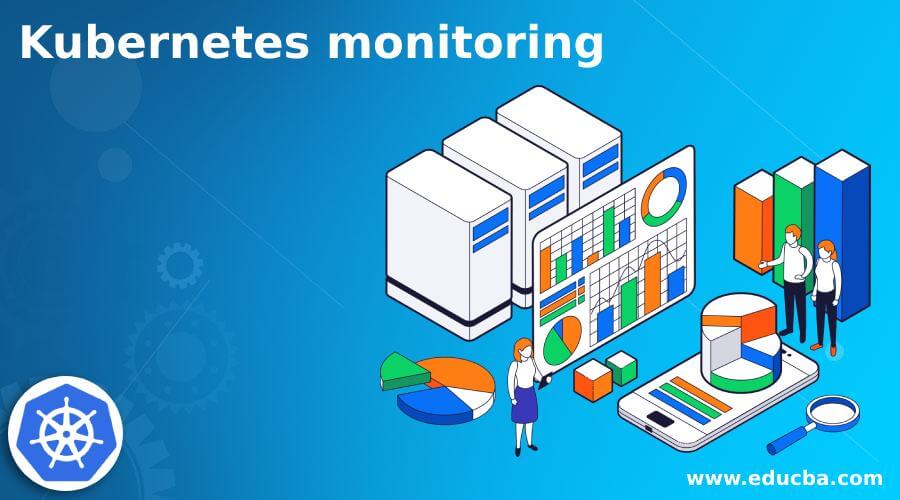Updated June 30, 2023

Introduction to Kubernetes Monitoring
In Kubernetes monitoring, as the name suggests, with the help of this, we do a report which helps us keep track of our cluster; by using this, we can easily manage our cluster. Managing clusters through monitoring helps and eases keeping track of the infrastructure resources, including memory, storage CPU, etc. With the help of monitoring, we can even alert for specific events. If any pods are not running, we can receive alerts for this. Also, it keeps track of any failure. Limits reach for particular resources or pods that are no longer working. Then we can keep this track or monitor this with the help of Kubernetes monitoring; in the coming section of the tutorial, we will see its internal working in detail for better clarity and understanding.
Why is Kubernetes Monitoring Important?
There will always be a benefit and importance of monitoring our application because it helps us keep track of the activity going on for the application and inform us about the performance, failure, memory, etc. As we have already discussed but let’s start with some of the major important factors of Kubernetes monitoring, which states why it is important to see below:
- It helps us to generate the reporting, which helps us to manage our clusters.
- With the help of this, we can easily generate alerts in case of any failure.
- We can keep track of the pods running and what are all ones taking part.
- Using this, we can keep track of the resources such as storage, memory, CPU, etc.
- It helps organizations to take a deeper look at the application.
- With the help of this, we can take a deeper look at the docker, containerization, cluster, and other infrastructure parts.
Top Kubernetes Monitoring Tools
Kubernetes provides many open-source tools that help us thoroughly monitor your application and its infrastructure. It also provides us with many add-ons, but it’s very complex. As we saw that continuous monitoring of our application is essential, and we have many numbers of free solutions which provide us with the free monitoring of the application, here we will be going to discuss the various tools provided by Kubernetes to monitor the application as follows:
1. Grafana
It is one of the monitoring tools and an open-source platform for visualization and analytics. It provides us with four dashboards that help us monitor our application, including deployment, Cluster, Pod/Container, and Node. Inside Kubernetes, we can easily install Grafana with the help of Kubernetes admin. So it is easy to use and handle and also helps monitor every part of the application.
2. Prometheus
It is also one of the monitor tools and an open-source platform we can use for alerting; it is very popular among the monitor tools. It helps us to get the metrics, analysis, and docker information. This tool is designed to monitor our application and microservices, which are running inside the scale of the container. It does not provide any dashboard because it is not, but we can integrate this with the Grafana tool we discussed before to visualize our application data with the help of the dashboard it provides.
3. Dashboard
It is a Kubernetes Dashboard, which helps us visualize data; it is said to be a UI for the Kubernetes clusters, which allows us to monitor the application’s health, status, workloads, etc.
4. Jaeger
It is also one of the monitoring tools, which helps in troubleshooting, transactions in complex distributed systems. It is designed to address the software issues arising from distributed systems, such as context propagation, transactions, latency monitoring, and more. So it is designed to monitor distributed systems etc.
5. Weave Scope
It is also a tool for monitoring and visualization of the infrastructure metrics. It also covers the entire infrastructure for us; weaveworks originally developed it, and it is also a graphical UI that helps us to visualize the statistics the helps of this, we can easily run the commands on the containers and manage them.
6. InfluxDB
It is designed for stirring very high-volume monitoring logs or records. Also provide high availability, and scalability, with clustering. It can be considered the long time storage of monitoring data which can serve as historical data or records later.
Best Kubernetes Monitoring Practices Methods
We have seven different monitoring practices methods that should be followed, as mentioned below.
- We should dig more for system visibility.
- We should capture the historical system data.
- Try to inspect the Kubernetes control panel for detail.
- Look more into the dashboards and alerts for a details investigation.
- Try to choose a SaaS-based monitoring system.
- We should try to evaluate the strategy.
- Embedded context.
Kubernetes Monitoring Solution
Monitoring solution means how we can monitor our system, which we have discussed already by using the tools, we have several different open-source tools which help us and provide us the solution to monitor the application.
Also, we have seen the best-practice methods which help and guide us to make the best possible approach to monitor the system, like we can monitor the control panel, it also provides us different components to do so. Some of the solutions for monitoring are mentioned below;
- cAdvisor
- The ELK Stack
- kubewatch
- kube-ops-view
- Prometheus Operator
- and many more
Conclusion
As we have seen all the benefits, why to use, and how it helps us to monitor our application, it also keeps track of the failure; go through the whole article to understand the importance of the Kubernetes monitoring, easy to use, maintainable and handle by the developers.
Recommended Articles
We hope that this EDUCBA information on “Kubernetes Monitoring” was beneficial to you. You can view EDUCBA’s recommended articles for more information.

